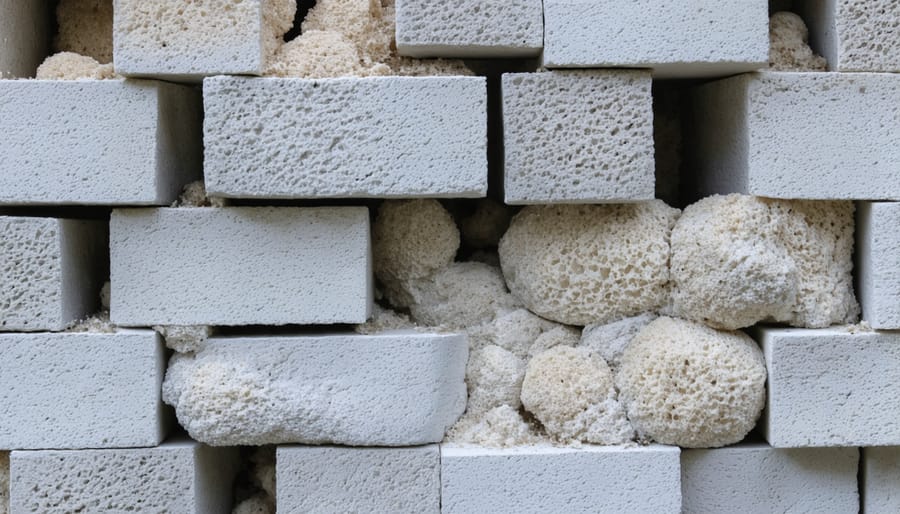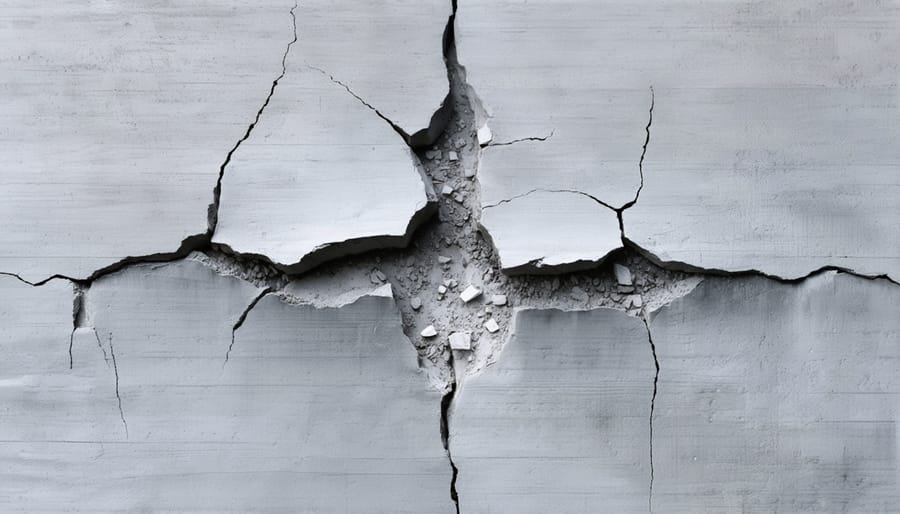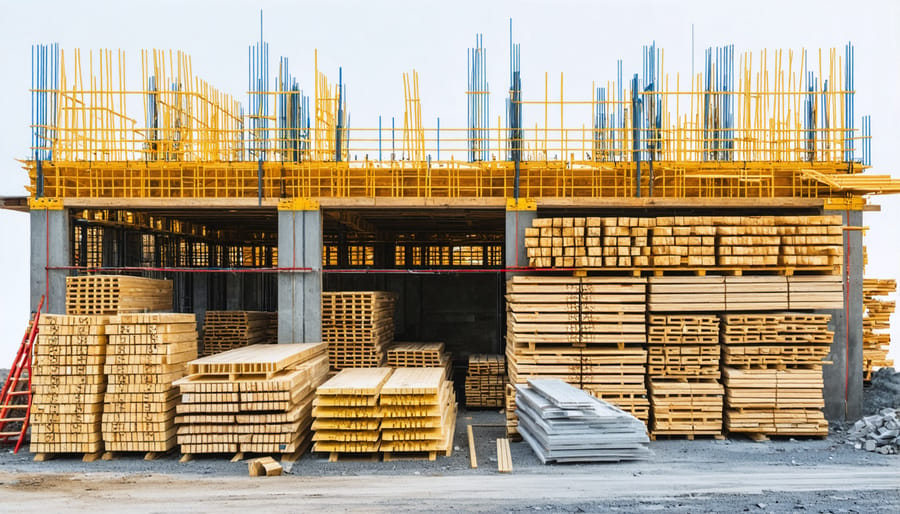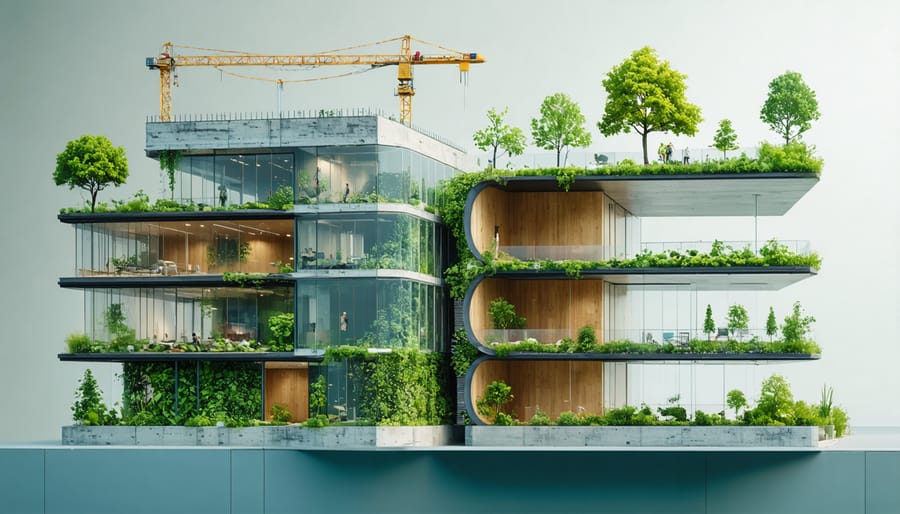Revolutionary breakthroughs in building materials are reshaping the future of sustainable construction, driving unprecedented innovation in structural performance, environmental impact, and construction efficiency. From self-healing concrete infused with bacteria to transparent aluminum-based materials that rival traditional glass in strength while delivering superior thermal efficiency, the construction industry stands at the threshold of a transformative era. These advancements aren’t merely theoretical—they’re already being implemented in pioneering projects worldwide, reducing carbon footprints by up to 70% while simultaneously cutting construction costs by 30%. As global construction demands surge and environmental regulations tighten, these innovative materials represent not just technological achievement, but essential solutions for meeting the industry’s most pressing challenges. The convergence of nanotechnology, biomimicry, and advanced manufacturing processes has unlocked possibilities that were inconceivable just a decade ago, fundamentally altering how we approach building design, construction methodology, and long-term infrastructure sustainability.
Bio-Based Building Materials Leading the Green Revolution
Mycelium-Based Construction Materials
Mycelium-based materials represent one of the most promising frontiers among emerging sustainable building materials. These innovative composites are created by combining agricultural waste with fungal mycelium, which acts as a natural binding agent through its network of microscopic fibers.
Recent structural testing has demonstrated impressive mechanical properties, with compressive strengths ranging from 30 to 70 psi (depending on density and cultivation conditions). While not suitable for primary structural elements, mycelium composites excel in non-load-bearing applications such as insulation, acoustic panels, and interior partition walls.
The material’s key advantages include superior thermal insulation (R-value of 3 per inch), excellent acoustic absorption coefficients (0.9 NRC), and inherent fire-resistant properties. Additionally, mycelium-based materials are completely biodegradable and require minimal energy input during production, resulting in a negative carbon footprint.
Several pioneering projects have successfully implemented mycelium materials, including The Living’s Hy-Fi tower in New York, which demonstrated their viability in architectural applications. However, challenges remain in standardization and scaling production to meet commercial construction demands.
Current research focuses on optimizing growth conditions and strengthening structural properties through various substrate combinations and processing techniques. Industry experts project significant market growth for mycelium-based construction materials over the next decade, particularly in sustainable architecture and interior applications.

Advanced Engineered Wood Products
Mass timber and engineered wood products represent a significant leap forward in sustainable construction technology. Cross-laminated timber (CLT) leads this revolution, offering exceptional structural strength comparable to concrete and steel while maintaining a significantly lower carbon footprint. These innovative materials are manufactured by layering wood strips in alternating directions, creating robust panels that can support impressive loads while maintaining dimensional stability.
Recent advancements have introduced new variants like mass plywood panels (MPP) and dowel-laminated timber (DLT), which offer enhanced performance characteristics without relying on adhesives. These products demonstrate superior fire resistance, with char layers forming protective barriers that maintain structural integrity during fires, often outperforming traditional building materials.
The integration of digital fabrication technologies has revolutionized engineered wood manufacturing, enabling precise customization and reducing waste. Modern facilities utilize computer-controlled cutting systems to create complex architectural elements with remarkable accuracy, streamlining on-site assembly and reducing construction timelines.
Notably, these products are gaining traction in high-rise construction, with projects worldwide demonstrating their viability in tall buildings. The Milwaukee Tower, completed in 2022, showcases how mass timber can be successfully implemented in 25-story structures while meeting stringent building codes and sustainability requirements.
These materials also offer significant environmental benefits, sequestering carbon throughout their lifecycle and requiring less energy to manufacture compared to traditional building materials. As building codes evolve to accommodate these innovations, engineered wood products are positioned to transform modern construction practices.
Smart Materials Enhancing Building Performance
Self-Healing Concrete Technologies
Self-healing concrete technologies represent a groundbreaking advancement in construction materials, offering solutions to one of the industry’s most persistent challenges: structural deterioration. At the forefront of this innovation is bacterial concrete, which incorporates specially selected bacteria strains that activate when cracks appear in the concrete matrix.
These microorganisms, typically Bacillus species, remain dormant within the concrete until exposed to water through crack formation. Upon activation, they produce limestone (calcium carbonate) through their metabolic processes, effectively sealing cracks up to 0.8mm wide. This biological approach to concrete repair significantly reduces maintenance costs and extends infrastructure lifespan.
Beyond bacterial solutions, advanced polymer-based systems have emerged as effective self-healing mechanisms. These systems utilize embedded microcapsules containing healing agents that rupture when cracks form, releasing compounds that solidify and seal the damage. Some variants employ vascular networks within the concrete, mimicking the human circulatory system to deliver healing agents throughout the structure.
Recent field trials have demonstrated impressive results, with self-healing concrete structures showing up to 60% recovery in structural integrity after damage. Implementation costs remain a consideration, typically adding 20-30% to traditional concrete expenses. However, lifecycle cost analyses indicate significant long-term savings through reduced maintenance requirements and extended service life.
Research continues in developing more efficient healing mechanisms and reducing production costs, with several promising applications already in use in critical infrastructure projects worldwide.

Phase-Change Materials for Temperature Control
Phase-change materials (PCMs) represent a significant breakthrough in building thermal regulation, offering sophisticated temperature control through their unique ability to absorb, store, and release thermal energy. These innovative materials transition between solid and liquid states at specific temperatures, effectively maintaining consistent indoor temperatures while reducing HVAC energy consumption by up to 30%.
Contemporary PCMs utilized in construction typically consist of organic compounds, such as paraffin waxes, or inorganic substances like hydrated salts. When integrated into building elements such as walls, ceilings, or flooring systems, PCMs absorb excess heat during peak temperatures and release it when temperatures drop, creating a natural thermal buffering effect.
Recent advancements have led to microencapsulated PCMs, which can be incorporated into traditional building materials like gypsum board, concrete, and insulation. This integration provides enhanced thermal mass without significant structural modifications. For instance, a leading European manufacturer has developed PCM-enhanced drywall that can store up to 330 kJ/m² of thermal energy, significantly outperforming traditional building materials.
Implementation costs remain a consideration, with PCM solutions typically commanding a 20-30% premium over conventional materials. However, the ROI analysis demonstrates average payback periods of 3-5 years through reduced energy costs, making them increasingly attractive for commercial and high-performance residential projects. As manufacturing scales up and technology advances, these costs are expected to decrease, potentially making PCMs a standard feature in future construction projects.
Recycled and Upcycled Building Components
Plastic-Based Construction Materials
The construction industry’s adoption of recycled plastic materials marks a significant advancement in sustainable building practices, aligning with modern zero waste initiatives. Recent developments have yielded remarkable innovations, including structural lumber alternatives manufactured from mixed plastic waste, which demonstrate comparable strength to traditional wooden beams while offering superior weather resistance and longevity.
Engineering firms have successfully developed composite materials combining recycled plastics with mineral additives, creating robust building components that meet international construction standards. These materials exhibit exceptional thermal insulation properties, with R-values up to 30% higher than conventional materials, while significantly reducing construction waste.
Field testing has shown that plastic-based construction materials maintain structural integrity for over 50 years with minimal maintenance requirements. Recent implementations in commercial projects have demonstrated a 40% reduction in carbon footprint compared to traditional materials, while offering cost savings of 15-25% over their lifecycle.
Notable applications include interlocking wall systems, roofing tiles, and foundation insulation panels, all manufactured from post-consumer plastic waste. These innovations not only address environmental concerns but also provide practical solutions for modern construction challenges, particularly in moisture-prone environments where traditional materials may deteriorate rapidly.

Industrial Waste Integration
Industrial waste integration represents a significant breakthrough in sustainable construction, transforming manufacturing byproducts into valuable building materials. Steel slag, fly ash, and silica fume – traditionally considered industrial waste – are now being repurposed into high-performance concrete additives, significantly reducing both landfill waste and the carbon footprint of construction projects.
One notable innovation is the incorporation of ground granulated blast furnace slag (GGBS) into cement mixtures, which can replace up to 80% of traditional Portland cement. This integration not only reduces CO2 emissions but also enhances concrete durability and resistance to chemical attack. Similarly, fly ash from coal-fired power plants is being utilized to create “green concrete,” improving workability and long-term strength while decreasing water demand.
Recent developments include the use of recycled glass powder as a supplementary cementitious material, which has shown promising results in enhancing concrete performance. Construction firms report up to 40% reduction in material costs when incorporating these industrial byproducts, while simultaneously achieving superior structural properties.
These innovations demonstrate how the construction industry can transform environmental challenges into opportunities, creating a circular economy where waste from one sector becomes a valuable resource for another.
Market Implementation and Future Prospects
Regulatory Framework and Certification
The regulatory landscape for innovative building materials encompasses various national and international standards that ensure safety, performance, and sustainability. Key certification bodies like ASTM International, ISO, and regional organizations establish testing protocols and performance criteria that new materials must meet before market introduction.
In the United States, materials must comply with International Building Code (IBC) requirements and obtain evaluation reports from organizations such as ICC-ES (International Code Council Evaluation Service). These reports provide evidence that new materials meet building code requirements through rigorous testing and documentation.
For sustainable materials, certifications like LEED, BREEAM, and Cradle to Cradle (C2C) play crucial roles in market acceptance. These programs evaluate materials based on environmental impact, recyclability, and lifecycle assessment. Additionally, Environmental Product Declarations (EPDs) have become increasingly important, providing transparent documentation of a material’s environmental performance.
The certification process typically involves multiple stages: initial testing, documentation submission, third-party verification, and ongoing compliance monitoring. Manufacturers must demonstrate their materials’ long-term durability, fire resistance, and structural integrity through standardized testing procedures.
Recent developments include streamlined certification pathways for innovative materials, recognizing the need to balance rigorous safety standards with faster market entry. Several jurisdictions have implemented performance-based approval processes, allowing manufacturers to prove compliance through alternative means while maintaining safety standards. This approach has particularly benefited bio-based and recycled materials entering the construction market.
Economic Viability and Scale-up Potential
The economic viability of innovative building materials hinges on several critical factors, including production scalability, market demand, and implementation costs. Recent market analyses indicate that while initial manufacturing costs for advanced materials may be higher, the long-term return on investment often justifies the upfront expenses through reduced maintenance and operational costs.
Industry research shows that materials like self-healing concrete and transparent wood are approaching cost parity with traditional alternatives as production processes become more efficient. The integration of these materials into the circular economy in construction further enhances their economic appeal through reduced waste and improved resource efficiency.
Case studies from leading construction firms demonstrate that scaling up production remains the primary challenge. For instance, graphene-enhanced materials show promising performance metrics, but manufacturing capacity currently limits widespread adoption. However, investments in automation and improved production techniques are steadily reducing costs, with some innovative materials seeing a 30-40% price reduction over the past five years.
Market readiness varies significantly across different material categories. While some innovations like advanced insulation materials have achieved commercial viability, others require further development of supply chains and manufacturing infrastructure. Industry experts project that most innovative building materials will achieve economic feasibility within the next 3-5 years, driven by increasing environmental regulations and growing demand for sustainable construction solutions.
The construction industry stands at a pivotal moment as innovative building materials continue to reshape sustainable construction practices. Through the integration of advanced technologies and eco-conscious design principles, these breakthrough materials are fundamentally transforming how we approach building projects. Self-healing concrete, transparent wood composites, and carbon-negative materials have demonstrated remarkable potential in reducing environmental impact while enhancing structural performance.
The adoption of these innovations promises significant benefits: reduced carbon footprints, improved energy efficiency, and enhanced building longevity. Smart materials incorporating nano-technology are enabling responsive building envelopes that adapt to environmental conditions, while bio-based materials offer sustainable alternatives to traditional construction components. The development of recyclable and reusable materials is creating circular economy opportunities within the construction sector.
Looking ahead, the impact of these innovations extends beyond environmental benefits. Economic advantages include reduced maintenance costs, improved operational efficiency, and increased building value. Moreover, the integration of these materials is driving new construction methodologies and design approaches that prioritize sustainability without compromising performance.
As the industry continues to evolve, the successful implementation of these innovative materials will depend on continued research, regulatory support, and industry collaboration. The future of sustainable construction lies in embracing these advances while ensuring their practical application meets both environmental goals and construction requirements. This transformation represents not just a trend, but a fundamental shift toward more responsible and efficient building practices.

